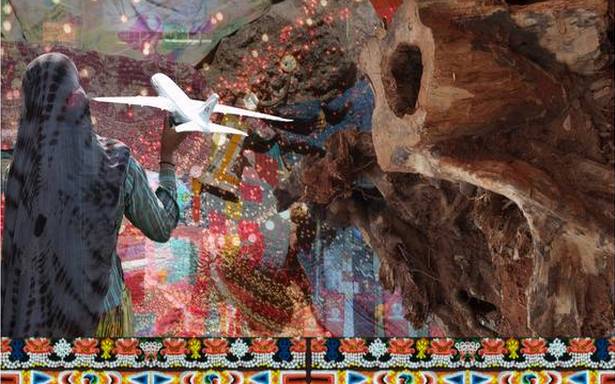ART NEWS
Bangalore to Bengaluru: Shanthamani M’s online exhibition, ‘Past Continuous’, portrays a city in flux
A series of photomontages attempts to capture the cultural transformation of Karnataka’s capital
A senior colleague and I started talking about Bangalore on our way to grab lunch on a workday two years ago, when going to the office and restaurants were quotidian affairs. The colleague, who was born and brought up in the city, told me, who had been living there for four years, how things used to be. She used to cycle, without traffic congestion, to Rex Theatre on Brigade Road, to Cubbon Park, to post offices, markets and other places. The city, she recalled, was much cooler, calmer, and greener. Six years into this millennium, Bangalore became Bengaluru. Along with the name, the city too changed drastically. At this point, the colleague paused for a moment and said, “It doesn’t feel like my city anymore.”Viewing Shanthamani M’s online exhibition at the Museum of Art and Photography, Past Continuous, rekindled the memory of this conversation. Her photomontages from the mid-2000s attempt to portray Bangalore’s transmogrification. Like my colleague, Shanthamani, too, has fond memories of a cooler, greener city. Despite growing up in Mysore, she has constantly visited Bangalore from the 80s. “I used to come to see exhibitions in Bangalore. This was the only place (near Mysore) where I could see works of other artists,” she says, “It was still a pub city and you would find people playing music on Brigade Road. But it had a different kind of balance and charm.”
Shanthamani’s work, however, isn’t a mere nostalgic trip. It was, rather, a project to capture a city in flux. By the mid-2000s, new buildings cropped up, roads expanded, trees fell, summers got hotter. All this was happening at a frantic pace. “It was generally the time when the density of the software community increased. And, the city geared up to cater to that community,” she says, “It changed the way the city worked. I could see and feel that.”It wasn’t that change itself or the pace of change that concerned Shanthamani; it was, she says, the kind of change the city opted for. “It had very much to do with the commercial parameters. A lot of the cultural identity of the city sort of got erased. For instance, people had to work even on important festivals in the city. They worked on American time, had American holidays; they even had to change their names and accents sometimes.”Mary in a sariOne of the montages features an image of a roadside Christian shrine topped by a cross emerging from a lotus. The shrine has a small Mary statue draped in a sari. The confluence of cultures and faiths in this virtually unknown shrine in a settlement in Ejipura piqued Shanthamani’s interest. It reminded her of the fusion of the symbols aum (Hindu), crescent (Islam) and cross (Christian) painted in many auto-rickshaws she has seen in Karnataka and elsewhere. “These things show that common people of different faiths don’t have hatred for each other. They are okay coexisting,” she says.The montages, however, are abstract. The accompanying write-ups, too, don’t entirely reveal the artist’s intentions. But Shanthamani feels it’s okay even if the audience doesn’t get it. “Every montage has a kind of sub-story. Even if the watcher doesn’t get the full extent of these stories, they can certainly identify with certain elements. I kept it open-ended for new interpretations, narrations and understanding.”Each montage in the exhibition has an accompanying writeup but it doesn’t convey what the artist is trying to sy. the exhibition are not explained. TheyEvery montage has a kind of sub-story. Even if the audience doesn’t get the full extent of these stories, they can identify with certain elements. They pick up fragmented things, stories and memories contained in that picture. In a way, it works in different layers.At the same time, it is not a photo-documentary. The montages try to tell a story of what’s happening on the ground level. They convey what is happening at that particular point of time in Bangalore. (The aeroplane montage) The background color is actually a quilt used in a construction by labourers who come here for work from North Karnataka. This is overlapped with the glittering lights from Brigade Road on New Year’s Eve. Everything from the montage has come from some street or the other in the city. I wanted to say something but at the same time I kept it open-ended for new interpretations, narrations and understanding.











